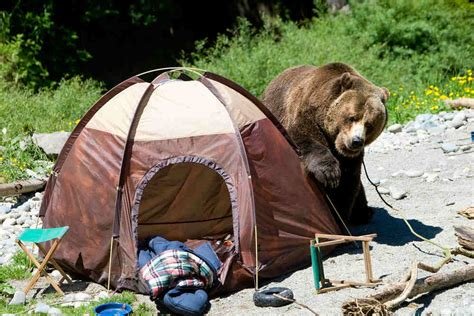Camping and Wildlife Encounters: How to Stay Safe and Respecful
Are you an avid camper and nature enthusiast? Do you love the thrill of spotting wildlife in their natural habitats? If so, it’s crucial to arm yourself with the knowledge and understanding of how to stay safe and respectful when encountering wildlife during your camping trips. In this blog post, we will delve into the essential tips and guidelines for ensuring a harmonious coexistence with the local wildlife. From researching the local wildlife before your trip and safely spotting them from a distance to creating a secure campsite and proper food storage, we’ll cover everything you need to know to minimize wildlife encounters and prevent any potential conflicts. We will also discuss the dos and don’ts of interacting with wildlife, as well as the significance of respecting their habitats and leaving no trace. So, grab your camping gear and get ready to embark on an adventure while practicing responsible and ethical wildlife viewing.
Understanding the importance of wildlife conservation
Wildlife conservation is crucial for maintaining the balance of ecosystems. Protecting the diverse range of animal and plant species is essential for the well-being of the planet as a whole. Preserving wildlife also contributes to the sustainability of natural resources and helps in maintaining the food chain.
It is important to understand that wildlife conservation is not just about safeguarding animals and their habitats. It is also about protecting the environment and the overall health of the planet. Biodiversity is vital for the stability of ecosystems, and without wildlife conservation efforts, many species may face extinction.
Conserving wildlife also has cultural and economic significance. Many communities around the world depend on the resources provided by wildlife for their livelihoods. Additionally, wildlife tourism is a major source of income for various regions. By upholding wildlife conservation, we are also supporting the economy and cultural heritage of these communities.
By promoting wildlife conservation, we are not only safeguarding the planet’s natural heritage but also ensuring a sustainable future for generations to come. It is a responsibility that should be taken seriously by individuals, communities, and governments worldwide.
Researching the local wildlife before your camping trip
Before embarking on a camping trip, it is essential to conduct thorough research on the local wildlife in the area you plan to visit. This will not only enhance your overall experience, but it will also help ensure the safety of both yourself and the wildlife.
When researching the local wildlife, it is important to familiarize yourself with the habitat and behavior of the animals that reside in the area. Understanding their natural habits will allow for a more enjoyable camping experience while minimizing the risk of unwanted wildlife encounters.
Furthermore, it is crucial to educate yourself on the endangered species that may be present in the area. By being aware of the vulnerable wildlife, you can take measures to avoid disturbing their habitats and contribute to their conservation efforts.
By taking the time to research and understand the local wildlife before your camping trip, you can fully appreciate the natural beauty of the area while promoting the conservation of its inhabitants.
Tips for safely spotting wildlife from a distance
When venturing into the great outdoors, spotting wildlife from a safe distance can be an exciting and rewarding experience. However, it’s crucial to remember that wildlife can be unpredictable and dangerous if approached too closely. Here are some tips to help you safely spot wildlife from a distance.
First and foremost, always use binoculars or a zoom lens to view wildlife from a safe distance. This will allow you to observe animals in their natural habitat without disturbing them or putting yourself in harm’s way. It’s important to respect their space and not invade their territory.
Another tip is to make yourself visible by wearing bright colors and making noise as you walk. This will alert animals to your presence and give them the chance to move away from you. Additionally, try to stay downwind from the animals as much as possible to avoid being detected by their keen sense of smell.
Lastly, it’s essential to do your research on the behavior and habits of the specific wildlife you are hoping to encounter. Understanding their patterns and preferred habitats will increase your chances of safely spotting them from a distance without causing any harm.
Creating a secure campsite to minimize wildlife encounters
When setting up your campsite in a wildlife area, it’s important to take precautions to minimize encounters with animals. One of the most effective ways to do this is by creating a secure campsite that deters wildlife from venturing too close. This not only protects you and other campers, but it also helps to keep the wildlife safe from any potential harm.
One tip for creating a secure campsite is to keep your cooking and eating area away from your sleeping area. This means setting up your tent and sleeping bags at a distance from where you will be preparing and consuming food. By doing this, you reduce the chances of attracting wildlife to your sleeping quarters.
Another important step is to properly dispose of your trash and food waste. Make sure to store all food in secure containers and dispose of any trash in designated bins. Leaving food scraps and garbage lying around can attract wildlife to your campsite, so being diligent about waste disposal is crucial in minimizing encounters.
Additionally, consider using bear-resistant containers for storing food and scented items. These containers are designed to keep wildlife out and are highly effective in preventing animals from being attracted to your campsite. Using these containers not only protects your food, but it also helps to keep the wildlife in the area safe.
Proper food storage to prevent attracting wildlife
Proper food storage is crucial when camping or hiking in wildlife areas to prevent attracting wildlife to your campsite. When food is left out or improperly stored, it can attract animals such as bears, raccoons, and rodents, posing a risk to both the wildlife and campers.
One of the best ways to prevent attracting wildlife is to use bear-proof food containers or bear bags to store all food, trash, and scented items. Keep these containers at least 100 yards away from your sleeping area to minimize the chance of a wildlife encounter in the middle of the night.
It’s also important to clean up after every meal and properly dispose of any food scraps or wrappers. Never leave food unattended, and be sure to carefully seal all food items in airtight containers to minimize smells that could attract animals.
Additionally, educating yourself and your camping partners on the proper food storage techniques and wildlife safety guidelines is crucial to preventing encounters and keeping both campers and wildlife safe.
The dos and don’ts of interacting with wildlife
When interacting with wildlife, it is important to remember that we are visitors in their natural habitat. One of the most crucial dos is to observe from a distance. Whether it’s a bird, a deer, or a bear, it’s best to admire them from afar to avoid causing distress or provoking an attack. This also ensures the safety of both the animal and yourself.
On the other hand, one of the don’ts of interacting with wildlife is feeding them. Feeding wildlife can disrupt their natural feeding habits, as well as make them reliant on human food sources. This can lead to aggressive behavior and increase the risk of them contracting diseases from human food. Therefore, it is essential to refrain from feeding any wild animals.
Another important do is to research the wildlife in the area before your visit. Understanding the habits and behaviors of the local wildlife can help you anticipate their movements and avoid dangerous encounters. This can also help you be prepared for any wildlife you may encounter on your journey.
Lastly, one of the key don’ts of interacting with wildlife is to avoid approaching or chasing animals. This can cause them unnecessary stress and can lead to dangerous situations for both parties. It’s always best to let the wildlife go about their business undisturbed.
Respecting wildlife habitats and leaving no trace
Respecting wildlife habitats is essential for the preservation of our natural ecosystems. It is important to remember that wildlife plays a crucial role in maintaining the balance of nature and that their habitats should be treated with the utmost respect.
Leaving no trace when interacting with wildlife is equally important. This means that visitors should strive to minimize their impact on the environment and wildlife by practicing responsible behavior and following guidelines set forth by conservation organizations.
When visiting a wildlife habitat, it is crucial to follow all guidelines set by park authorities. These can include staying on designated trails, keeping a safe distance from wildlife, and refraining from feeding or approaching animals.
Additionally, leaving no trace also entails properly disposing of waste, refraining from littering, and minimizing noise pollution. By doing so, we can ensure that wildlife habitats remain preserved and that future generations can continue to enjoy them.
Frequently Asked Questions
Why is it important to understand the importance of wildlife conservation?
Understanding the importance of wildlife conservation is crucial to ensure the protection and preservation of natural ecosystems and their inhabitants. It also helps to maintain a balanced and thriving environment for both wildlife and human beings.
How can I research the local wildlife before my camping trip?
You can research the local wildlife by checking with the local parks and wildlife authorities, using field guides or wildlife apps, and studying the habitats and behaviors of the wildlife species in the area you are visiting.
What are some tips for safely spotting wildlife from a distance?
Some tips for safely spotting wildlife from a distance include using binoculars or a camera with a zoom lens, being patient and quiet, and avoiding sudden movements that may startle the wildlife.
How can I create a secure campsite to minimize wildlife encounters?
You can create a secure campsite by properly storing food and garbage in wildlife-proof containers, keeping a clean campsite, and setting up tents and cooking areas away from wildlife trails and habitats.
What is the proper food storage to prevent attracting wildlife?
Proper food storage to prevent attracting wildlife includes storing food in airtight containers, keeping food away from sleeping areas, and disposing of food scraps and garbage in designated containers or areas.
What are the dos and don’ts of interacting with wildlife?
The dos of interacting with wildlife include observing from a safe distance, staying quiet and not approaching or feeding wildlife. The don’ts include getting too close, making loud noises, and attempting to touch or handle wildlife.
How can I respect wildlife habitats and leave no trace?
You can respect wildlife habitats and leave no trace by staying on designated trails, avoiding trampling vegetation, and properly disposing of waste and not damaging or removing wildlife or natural objects.






